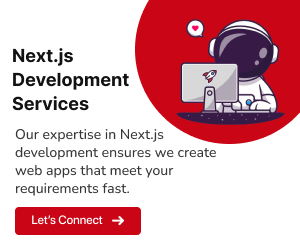In the ever-evolving world of web development, staying ahead of the curve is crucial. One technology that has been gaining significant traction in recent years, especially in the United States, is Next.js. This open-source JavaScript framework, built on top of React, has been a game-changer for web developers across the nation. Its rapid ascent reflects the growing demand for faster, more efficient, and feature-rich web applications. In this blog, we’ll dive deep into the future of Next.js app development in the USA, covering its current state, its advantages, potential challenges, and what lies ahead, all in the context of a digital landscape where innovation and user experience reign supreme.
The digital world has never been more competitive, and user expectations continue to soar. As businesses strive to provide seamless online experiences, Next.js emerges as a beacon of hope, offering a potent blend of versatility and performance. This framework’s journey is not just about technology; it’s about the relentless pursuit of excellence in crafting web solutions that captivate and delight users, and its evolution promises to redefine the very essence of web development in the USA.
The Current State of Next.js in the USA
Next.js has rapidly become the go-to choice for web developers in the USA, and for good reason. Its ease of use, flexibility, and performance optimizations have made it a staple in modern web development.
Let’s delve deeper into its current state with a point-wise breakdown
Wide Adoption:
Next.js has witnessed widespread adoption among companies of all sizes. Notable giants like Netflix, Uber, and TikTok have integrated Next.js into their tech stacks, underscoring its scalability and reliability. However, it’s not just the big players; countless startups and smaller enterprises have also turned to Next.js to build their web applications.Server-Side Rendering (SSR):
One of Next.js’s standout features is server-side rendering (SSR). This method allows web pages to be pre-rendered on the server, resulting in faster initial page loads and better SEO performance. This capability addresses the critical need for speed and search engine visibility in the competitive online landscape.Developer Productivity:
Next.js places a strong emphasis on developer productivity. It offers features such as automatic code splitting, built-in CSS support, and hot module replacement. These features streamline the development process, allowing developers to focus on building features and functionality rather than getting bogged down in optimization and setup tasks.Modular Architecture:
Building on React’s component-based architecture, Next.js encourages modularity in web development. Its routing capabilities simplify the creation of complex web applications while maintaining codebase cleanliness. This modular approach promotes code reusability, making it an ideal choice for large-scale projects.Community Support:
Next.js benefits from a vibrant and growing community of developers. This community actively contributes to its ecosystem by creating plugins, extensions, and sharing best practices. This support ensures that Next.js remains up-to-date with the latest web development trends and technologies.
Advantages of Next.js for App Development
The advantages of Next.js extend beyond SSR. It has a plethora of features that enhance developer productivity, making it a go-to choice for many.
These features include
Improved Page Load Speed:
Next.js’s server-side rendering (SSR) significantly reduces initial page load times. With SSR, web pages are pre-rendered on the server, ensuring that users see content faster. This speed boost not only enhances user experience but also positively impacts SEO, as search engines favor faster-loading websites.
SEO-Friendly:
Next.js’s SSR capabilities, combined with its dynamic routing system, make it inherently SEO-friendly. Search engines can easily crawl and index pages, resulting in improved search engine rankings. This is a crucial advantage for businesses striving to gain visibility in search results.Developer Productivity:
Next.js simplifies development with features like automatic code splitting, built-in CSS support, and hot module replacement. Developers can be more productive and focus on building features and functionality, rather than spending excessive time on optimization and configuration.Code Reusability:
Built on React’s component-based architecture, Next.js encourages code modularity. This modularity enables developers to create reusable components, reducing redundancy and improving code maintainability. It’s particularly beneficial for large-scale projects with multiple developers.Community and Ecosystem:
Next.js benefits from a thriving community of developers and a growing ecosystem. This active community contributes plugins, extensions, and documentation, making it easier for developers to find solutions to common challenges and stay updated with the latest best practices.Performance Optimizations:
Next.js incorporates performance-focused features such as image optimization and automatic font loading. These optimizations result in faster page rendering and better overall performance, crucial for retaining user engagement and satisfaction.Serverless Functions:
With Next.js, developers can easily create serverless functions. This capability aligns with the serverless computing trend, allowing for efficient scaling of backend processes without the need to manage traditional servers. It’s a cost-effective solution for dynamic web applications.Static Site Generation (SSG):
Next.js supports static site generation (SSG), a method that generates static websites with dynamic data. SSG is highly efficient for websites that don’t require real-time data updates but still want the benefits of fast-loading static content.Versatility:
Next.js’s versatility enables developers to build various types of applications, from single-page applications (SPAs) to e-commerce platforms and blogs. It provides the flexibility to choose the best rendering method and architecture for each project’s unique requirements.E-commerce Integration:
Next.js has found a strong foothold in the e-commerce sector. Its ability to deliver fast-loading product pages and dynamic shopping experiences has made it an excellent choice for online retailers aiming to provide a seamless shopping journey for customers.
Challenges and Considerations

Despite its many advantages, Next.js app development in the USA presents certain challenges that developers and businesses need to navigate effectively.
Here are some key considerations
Talent Shortage:
As Next.js gains popularity, there is a growing demand for skilled Next.js developers. However, finding and hiring experienced developers can be challenging. Companies may need to invest in training or consider alternative solutions to bridge this talent gap.Evolving Ecosystem:
Next.js is closely tied to React and the broader JavaScript ecosystem, which evolves rapidly. Staying up-to-date with the latest libraries, best practices, and emerging technologies is essential to harness the full potential of Next.js. This continuous learning curve can be demanding for developers and development teams.Complexity of Server-Side Rendering:
While SSR offers performance and SEO advantages, implementing it can be complex, especially for developers new to this concept. Ensuring that server-side rendering is correctly configured and optimized can be challenging and may require additional effort.Scalability Challenges:
As web applications built with Next.js grow in popularity, scalability can become an issue. Proper planning and architecture are crucial to handle increasing user traffic and data demands. Scaling Next.js applications, especially those involving serverless functions, requires careful consideration.Third-Party Integration:
Integrating third-party services and libraries into a Next.js application can be challenging due to the asynchronous nature of JavaScript. Ensuring seamless compatibility and minimizing potential conflicts with external dependencies can require thorough testing and development effort.
The Future of Next.js in the USA

Looking ahead, Next.js is poised to continue its growth in the USA. Its ability to create fast, SEO-friendly, and scalable web applications will remain highly coveted. One significant aspect of Next.js’s future lies in its potential to evolve in line with the ever-changing web development landscape.
Anticipated advancements may include
Widespread Adoption Continues:
Next.js is poised to maintain its upward trajectory in the USA. As more businesses witness its advantages in terms of speed, SEO, and developer productivity, adoption will likely continue to grow across various industries. We can expect to see even more diverse use cases, from e-commerce and SaaS platforms to media and entertainment applications.Enhanced Serverless Functionality:
Serverless computing has been gaining momentum, and Next.js is likely to incorporate more robust serverless functionality. This could mean better integration with serverless platforms like AWS Lambda or Azure Functions, enabling developers to create highly scalable and cost-effective backend services seamlessly.Real-time Capabilities:
As real-time applications become increasingly important, Next.js may evolve to offer improved support for real-time data updates. This could lead to the development of more dynamic and interactive web applications that blur the line between traditional websites and native applications.Integration with Popular Databases:
Streamlined integration with popular databases and data management systems is another area where Next.js may expand. This would simplify data handling and storage for developers, reducing complexity and potentially lowering development costs.Improved Developer Tools:
The Next.js ecosystem is likely to witness continuous improvement in developer tools and extensions. These enhancements will empower developers to be more productive, automate common tasks, and accelerate the development process.Community-Driven Innovation:
The Next.js community will continue to play a pivotal role in shaping the framework’s future. With a thriving community of developers, we can expect to see innovative plugins, extensions, and best practices emerge, further enriching the Next.js ecosystem.Internationalization and Localization:
As businesses cater to global audiences, Next.js may introduce better support for internationalization and localization. This will enable developers to create multilingual and culturally sensitive applications with greater ease.Progressive Web Apps (PWAs):
Next.js has the potential to become an even more attractive choice for building Progressive Web Apps. Enhancements in this area could make it simpler to create web applications that deliver native-like experiences on various devices, including mobile.Improved Performance Optimizations:
As user expectations for speed and performance continue to rise, Next.js will likely continue to invest in performance optimizations. This could include more advanced image optimization, code splitting, and lazy loading techniques to deliver even faster web experiences.Accessibility and Inclusivity:
The focus on accessibility and inclusivity is expected to intensify. Next.js may incorporate features and tools to help developers build applications that are more accessible to users with disabilities, aligning with legal requirements and ethical considerations.
Related : The Impact of AI and Machine Learning on next.js App Development in the USA
Conclusion
In conclusion, the future of Next.js app development in the USA looks promising, driven by its current popularity, inherent advantages, and ongoing improvements. However, staying competitive in this field will require a commitment to learning and adaptation. As long as developers and companies continue to embrace Next.js and stay agile in the face of evolving technology, the framework will remain a cornerstone of web development in the United States.
As we anticipate the road ahead, it’s essential to acknowledge that the future of Next.js extends beyond code and development. It signifies a commitment to delivering outstanding user experiences, pushing the boundaries of what’s possible on the web, and ensuring that the digital realm remains an exciting and accessible space for everyone. The journey of Next.js is not just a technological one; it’s a testament to the relentless pursuit of excellence in creating web solutions that resonate with users and drive innovation across industries.


























